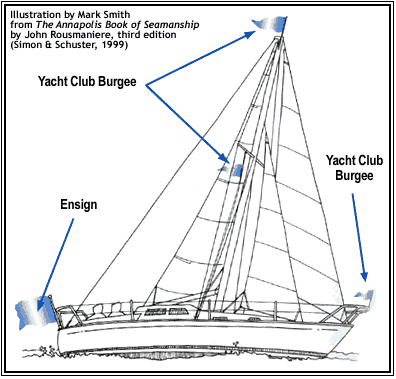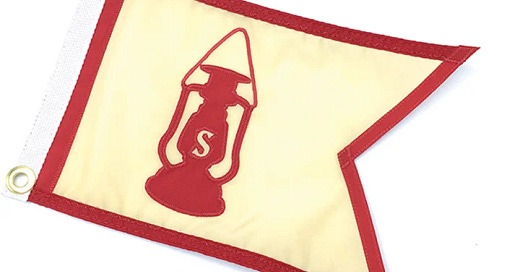Of all the important issues facing us, perhaps none is as pressing, as dire, as the need for boaters to better understand burgee etiquette. If you don’t believe me, just fly yours the wrong way in front of that old guy from the yacht club.
You know about burgees, right? They’re those the little flags bearing the colors and emblems of sailing clubs or groups. They’re often triangular, but sometimes swallow-tailed or sewn from other shapes. In addition to telling other boaters, at a glance, something about your club affiliations, burgees are also often traditionally exchanged when visiting other yacht clubs.
I’m not much for joining groups myself, but I do appreciate nautical traditions. And as Jonathan Lewis wrote for us recently, in some places you can’t even get fuel without the right affiliations.
The history of burgees can be traced to the nineteenth century when ship-owners flew custom-designed “private signals” from top of the ship’s tallest mast. These were unique to each ship so that they could be recalled to land by a corresponding flag signal ashore. Once owners started to own fleets, these “private signals” became associated with company flags or flags for different shipping lines.
Before we talk about how to fly a burgee, let’s settle on how to say burgee. It’s not BUR-gee, but bur-JEE—with the emphasis on the second syllable, a soft “g” sound.

Where to Fly It
Ah, yes…simple. Or maybe not. Most sources call for flying the burgee from a so-called pig stick (small pole) on a halyard to the head of the mast. Some sources note it should be the forward-most mast, others say after-most. Either way, using a pig stick is something of an art. While it demonstrates your salty skillset, often you’ll have an antenna, masthead light, or windex that could interfere with the stick, and flag chafe can also be a concern. As a result, most sailors fly their burgee instead from a halyard under the lowermost starboard spreader.
What if you have no spreaders? I don’t know. Maybe back to the pig stick for you. What if you have no mast or are looking for another option? Powerboats (and some sailboats) fly their burgee from a short staff (jack staff) at the bow or bow pulpit.
When to Fly It
It’s probably easier to identify when not to fly your burgee. Clubs will often have their own burgee rules, but for whatever reason, convention says it shouldn’t be flown when racing. It’s also said you shouldn’t fly more than one burgee at a time, showing only the one associated with whatever activity you’re participating in currently. Furthermore, burgees shouldn’t be flown unless the vessel is in the control of the club member. And whatever you do, be sure you don’t fly your burgee upside down.
I’ve personally been a part of creating several burgees—one for the Pocket Yachters, one for Small Craft Advisor, and one for our SCAMP sailboat design. It’s possible I’ve violated some rule or etiquette in their shape, design or purpose, but despite what I’ve written above I try not to take any of it too seriously. My favorite burgee is the one I got from the MOBYC (My Own Bloody Yacht Club) on Harkers Island in North Carolina—a “club” with no dues where simply owning the burgee means you can beach your boat in front of the Commodore’s waterfront home.
Whatever your own feelings about these traditions, some sailors and organizations don’t suffer any foolishness. As the Cruising Club of America notes dryly, “Flags shall be flown properly or not at all.” •SCA•
PDF by Philip Roberts with instructions for making and setting a pig stick below. Click to download.




My primary source of nautical etiquette is Patrick O'Brien, who has taught me that the purpose of flying flags is to confuse or deceive other ships. Therefore I prefer to think of my burgee placement as not wrong, but instead purposefully confounding to the "gin and tonics on the aft deck" crowd.
For the fun of knowing the tradition, I tried to educate myself on how to properly fly my flags and burgees.
For most sailboats, the highest point on a flag halyard, rigged to the spreader, on the starboard side is considered the place of highest precedence. This is where you would fly your burgee with any officer burgee going below.
However, if you are in foreign waters, this place of highest precedence is reserved for your courtesy flag with your burgee and officer flag being demoted to the port side flag halyard. When in Canadian waters, I like to fly my Canadian Courtesy flag as a way to show appreciation of being able to sail there. Fortunately, at least in the PNW, the Canadians are not too strict about insisting on this practice.
I have read though that in the Caribbean, coming into a new port without the proper courtesy flag can result in a fine and/or the mandatory purchase of a very expensive proper courtesy flag from the local port authorities.
And of course, your national flag should always be on the stern. The US Ensign, the one with the fouled anchor, is not appropriate when in international waters.